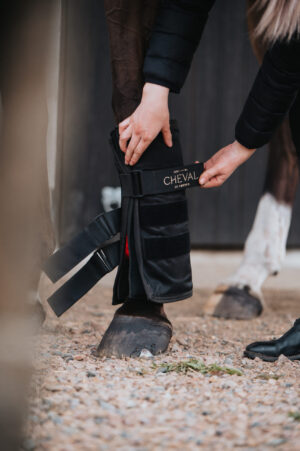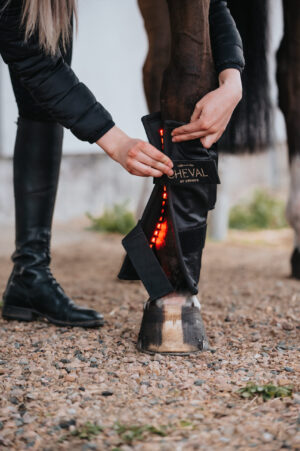[vc_row][vc_column][vc_empty_space height=”50px”][vc_column_text]
Arthritis (joint inflammation)
Joint inflammation, also known as arthritis, is a common condition affecting horses of all ages and breeds. It can cause pain, stiffness, and reduced movability, making it hard for your horse to perform.
Various options for treating arthritis in horses include medication, joint injections, physical therapy, and, in severe cases, surgery. Combining these with LED Treatment can significantly increase the chances of a successful recovery.
[/vc_column_text][vc_empty_space height=”50px”][/vc_column][/vc_row][vc_row][vc_column width=”1/2″][vc_column_text]
What is Arthritis?
Arthritis is a condition that can affect horses of all ages and breeds. In a healthy joint, the ends of the bones are covered by a smooth layer of cartilage. These layers act as shock absorbers and help to prevent the bones from rubbing against each other. The joint is also surrounded by a synovial membrane, which produces synovial fluid to help lubricate the joint and keep it moving smoothly.
When a horse gets arthritis, the protective cartilage becomes damaged or worn down, leading to inflammation and pain. The synovial membrane may also become inflamed, producing excess synovial fluid, which can cause swelling and further damage to the joint.
Causes of Arthritis in Horses
Overwork, trauma, infection, genetics, and autoimmune disorders are different factors that can cause arthritis in horses. Over time, the cartilage in a horse’s joints can wear down, leading to inflammation and arthritis. A horse that gets an injury, like a fracture or sprain, can be at higher risk for developing arthritis in the affected joint. In some cases, an infection in a joint can lead to arthritis. Certain breeds of horses may be more likely to develop arthritis due to their genetics, and sometimes, a horse’s immune system can mistakenly attack the joints, leading to inflammation and arthritis.
[/vc_column_text][/vc_column][vc_column width=”1/2″][vc_column_text]
Common Symptoms of Arthritis in Horses
The symptoms of arthritis in horses can vary depending on the severity and location of the affected joint. Common symptoms are stiffness, lameness, decreased range of motion, and swelling of the affected joint. Horses with arthritis can also show signs of pain or discomfort, such as reluctance to move or behavioural changes.
Where can Horses get Arthritis?
Horses can develop arthritis in various joints throughout their bodies. The most commonly affected joints are the lower leg joints, such as the fetlock, pastern, and coffin joints. However, arthritis can also occur in other joints, including the hock, knee, hip, shoulder, and spine. The specific joints affected may depend on factors such as the horse’s age, breed, and activities.
Are Joint Inflammation and Arthritis the Same Thing?
Yes, joint inflammation and arthritis are often used interchangeably to describe the same condition. Arthritis is a broad term used to describe any condition that causes inflammation in the joints, and joint inflammation is a key characteristic of arthritis.
[/vc_column_text][/vc_column][/vc_row][vc_row][vc_column][vc_empty_space height=”50px”][vc_column_text]
Recommended treatment options for arthritis in horses
Several treatment options are available for arthritis in horses, such as medication, joint injections, physical therapy, and surgery in severe cases. Complementing the treatment with LED Treatment, also known as Low-level laser therapy (LLLT), can remarkably enhance the recovery process in affected joints.
An LED Treatment System uses low-level laser energy to stimulate healing and reduce inflammation in the affected joint. Applying LED Treatment encourages the production of cellular energy (ATP), increases blood flow, and reduces inflammation – scientifically proven.
Using an LED Treatment System regularly can also help prevent arthritis from occurring again or even developing in the first place. Therefore, we recommend continuing the treatment even after the inflammation is gone.
Give your horse the best possible chance for a successful recovery.
[/vc_column_text][vc_empty_space height=”50px”]


